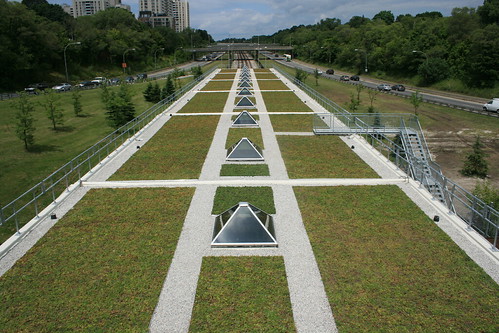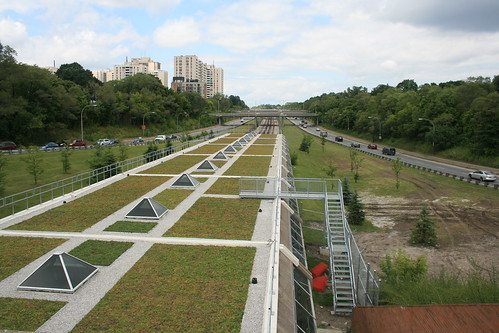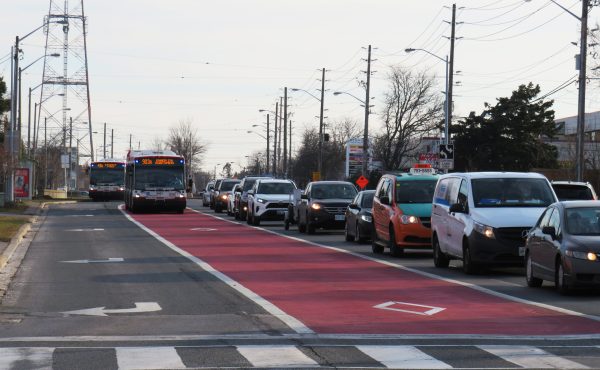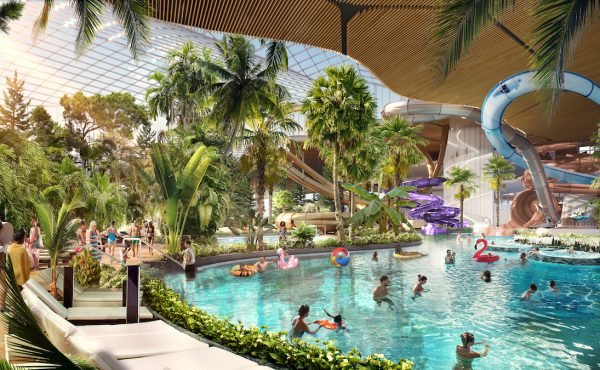TTC workers were out watering the new green roof on top of Eglinton West subway station yesterday morning. The 9,000 square-foot garden is planted almost entirely of sedums, looking like either a carpet of Hs or (appropriately) train tracks. Although originally criticized by some as “an expensive frill” one year ago, Terry McGlade pointed out in a recent interview that whether or not the new roof provides a noticeable change in the ambient temperature of the subway platform (which is open at the northern end), the insulation provided by the plants will significantly extend the roof’s lifespan.
Also, contrary to many other reports, the green roof is visible by transit users and not just drivers on the Allen, although behind glass. As you descend down to the subway platform, the roof is at eye level, allowing for a view of the sedum plots. From this angle, the lines of the garden seem to resemble the symmetry of an old English or French garden, the skylights becoming mini I.M. Pei pyramids (but maybe that’s going too far…).
I wonder whether the roof will ever be made publicly accessible, perhaps with occasional tours similar to the tours led on MEC’s green roof? The railing around the roof and the easily accessed outdoor stairwell near a door on the northbound subway platform almost seem as if they were designed with curious visitors in mind.
The Eglinton West subway station was designed by the late Arthur Erickson in partnership with Clifford & Lawrie and won a Canadian Architect Award for Excellence in 1968. Its new green roof may be the first ever to be built on top of a subway, so to make this roof at least semi-public would be a great opportunity for the TTC to draw some positive attention to itself amidst the recent streetcar funding fiasco and the lagging construction of the St. Clair West ROW.
Photos by Jake Schabas






21 comments
This is a great idea. I love the view out the window. I will go (by TTC) to visit the next time I am in TO.
Interesting to think that the track heading south from here, all the way to Dupont Station (with some breaks) also has a kind of green roof: the ravines above.
Great idea, but could they have given it some trees or larger plants at least?
Anything to distract one from the 1970s-era Loblaws store time travel sensation is an improvement!
The roof has been there for quite a while. I love it. It is definitely an improvement. Eglinton West is my home station, and this station was like a sieve during rainy days, and the winter. Since the roof was put in, I have noticed much fewer leaks, if any at all.
This is a waste of money. Maybe if the it is turned into some kind of public space (isn’t Muscoe pushing for this at Lawrence West Stn?) it could be somewhat okay, as it is though it is a totally irresponsible luxury. We basically sacrificed a bus for this.
a nice touch to the rehab of the stn…hopefully this is the start of a trend in the construction and rehab of other public buildings and more ttc buildings…
Based on the Terry McGlade interview, the roof is 9000 sq. ft., and the cost between $25 and $30 per sq. ft. That’s a total of $225,000 to $270,000, about half the cost of a diesel bus (around $500,000), and less than a third of the cost of a hybrid, (over $900,000).
In return, the roof will last longer, there is less leaking to damage and discolour the interior, and the temperature on the platform will be cooler in the summer and warmer in the winter. All this as a bonus to the main function of carbon capture.
This looks fantastic. Good work TTC! I hope to see this elsewhere.
I like the idea of this being accessible to the public, as a park of some nature.
I can’t see it being flooded by people, but it would still make it worth it.
As much as it may look nice the truth about green roofs is that they are a fad and only worth the money if there is some other economic or social reason to install it i.e. a rooftop garden for public use or have a bar. It is virtually impossible to get that additional value in a retrofit of an existing building like this because the roof is not designed to take the additional weight load imposed by public access. Environmental planning would say that to make the station cooler you are much better off to just put more insulation on the roof and use the money saved to buy a better heating system. The same point should be made about new City rule about green roofs on new buildings. It is a pointless waste of money to put a green roof on top of a condo that has a crappy glass facade that wastes energy in hot and cold weather and has a cheap, inefficient heating system. Sorry for bursting any bubbles.
“Anything to distract one from the 1970s-era Loblaws store time travel sensation is an improvement!”
============
Actually, the station was architecturally distinguished even without its green roof. And as for the green roof: if there’s any extant building (and architectural provenance) for which such a gesture seems just so harmoniously appropriate, this is it.
And as for the “we basically sacrificed a bus for this” comment; we basically earned back that bus money through the economics of green roofing, so it all balances out…
Cool! I’m going to have a picnic there, if it ever stops raining… 🙂
Have to agree with McD’s comment. Green roofs seem to be more about feeling good than anything else. Kind of like a sleight of hand directed at the folks who want to believe the City’s commitment to the environment, and are more than willing to ignore all the 1000s of glass-siding condo units built in recent years (and still being built) that are guaranteed to be energy pigs. There are other technologies that achieve the same energy savings as these roofs at much less cost — so that the added cost of the green roof is really only justified if it can achieve another objective, such as usable outdoor space, etc.
This is a total waste of money. Since the subway station is open at one end, there will be no savings on heating and cooling costs as there is no heating or cooling system. Furthermore, if the goal is to capture CO2, it would be far cheaper to just plant a few trees somewhere. Stop throwing away money on this kind of garbage and spend it on basic maintenance of TTC facilities.
The station design is interesting and quite good, I was commenting more on the aesthetic overload of brown tiles and orange trim in the finishes. The station would co-ordinate well with a brown leisure suit and orange dress shirt, and those brown TTC uniforms of the late 70s. Ugh.
Another issue … what is the life expectancy of the roof and what will it cost to repair when the roofing and membranes under the vegetation need to be replaced? If it lasts much longer than the standard roof finish, but costs more to repair, I’d still say it’s a break-even.
Fantastic! What a clean look to a grea idea and really enhances the appeal of the space/place! TTC draw positive attention toitself? I thought the government was already doing that for them through Transit City?
Andrew: If you ever used Eglinton West on a regular, you would know that the previous roof used to leak when it rained, and in the winter. Think patches of ice used to form on the platform. This IS basic repair, with a added twist.
It’s about time this station got some love. it’s one of the best stations in the system.
The nay sayers are quite off the mark with their comments. The cost of roof repair and maintenance alone will more than offset the additional cost of the green roof. The storm water run-off from the roof will be reduced by more than 50% on an annual basis. That will save the city significant money in storm sewer repair and maintenance. It also significantly improves the roof top temperature, in the process protecting the membrane from deterioration. The roof will also capture a significant amount of particulate matter exhausted and kicked up by traffic, resulting in slightly cleaner air. This building is open, so no energy savings from the cooling effect will result, but that is not the case for other sprawling buildings. A typical big box store could cut its air conditioning bill in half with the installation of a green roof. I have to agree that on top of a 20 story glass tower, energy savings are not significant, however the aesthetics are a lot better than a black or even a white roof. As for putting trees on Eglington West, that just isn’t going to happen in 90 mm of soil. The only plants that will survive are Sedums, Sempervivums, small Alliums and other related super tough plant species. No woody plant will survive that soil depth. For more information on green roofs and all their benefits go to the web site of Green Roofs for Healthy Cities (www.greenroofs.org).
This green roof will likely outlast the functional life of the station.
Justin,
It is a repair, but hardly a “basic repair” since it is sure to cost much more than if it were “repaired” in another way. Personally, I don’t think repairing it this way is a bad idea — providing that roof becomes useable space (which it probably won’t). Again, this is one of those examples where the city and its agencies always seem to be crying “poor us” — except for when it comes to one of their pet projects.
Adam: Sedums are chosen because they require very little water and soil. Larger plants need more soil and water, which means significantly greater weight as well as considerations for drainage. Sedums are a great first step.